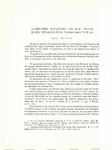Αλληγορική παράσταση του Βίου - Κάιρου σε μια μεταβυζαντινή τοιχογραφία στη Χίο

Προβολή/Άνοιγμα
Συγγραφέας
Μπούρας, Χ.Ημερομηνία
1967Γλώσσα
el
Εκδότης
Υπηρεσία Αρχαιοτήτων και Αναστηλώσεως
Λέξη-κλειδί
Βιβλιογραφικά στοιχεία
Αρχαιολογικόν Δελτίον, 1966, Τόμος 21, Μελέται/Μέρος Α’, 26-34.
Πρόσβαση
ελεύθερη
Τίτλος περιοδικού
Αρχαιολογικόν Δελτίον
Επιτομή
In a fresco, in the byzantine church of the Holy Virgin ( Panaghia Krina)
on the island of Chios, a work of the painter Michael Chomatzas ( 1734 ), the ancient
allegoric personification of « Kairos » is represented as a naked youth holding
a pair of scales in one hand, and seized by the forelock by a richly dressed man (PI. 14).
This theme originated in ancient Greece, but survived in the Middle Ages.
Some representations of Kairos ( Time ) are known in byzantine art, and some related
literary creations from the same period are also known ( poems and epigrams ).
Munoz first identified as the ancient allegoric figure of Kairos the well known marble
relief of the Cathedral of Torcello, and showed its connection with a poem of Theodore
Prodromos (12th cent.). The fresco in Chios, until now unknown, confirms
Munoz’s hypothesis since a long inscription with the same poem unaltered appears
near the figures. The original conception of the Kairos personification as
opportunity, was transformed in byzantine times to symbolize the pleasures of life.
With this meaning and with the new name of «Βίος» (Life) it is also represented in
the Chios fresco. The poem, and the figures there, have an instructive character,
emphasizing the vanity of life.


